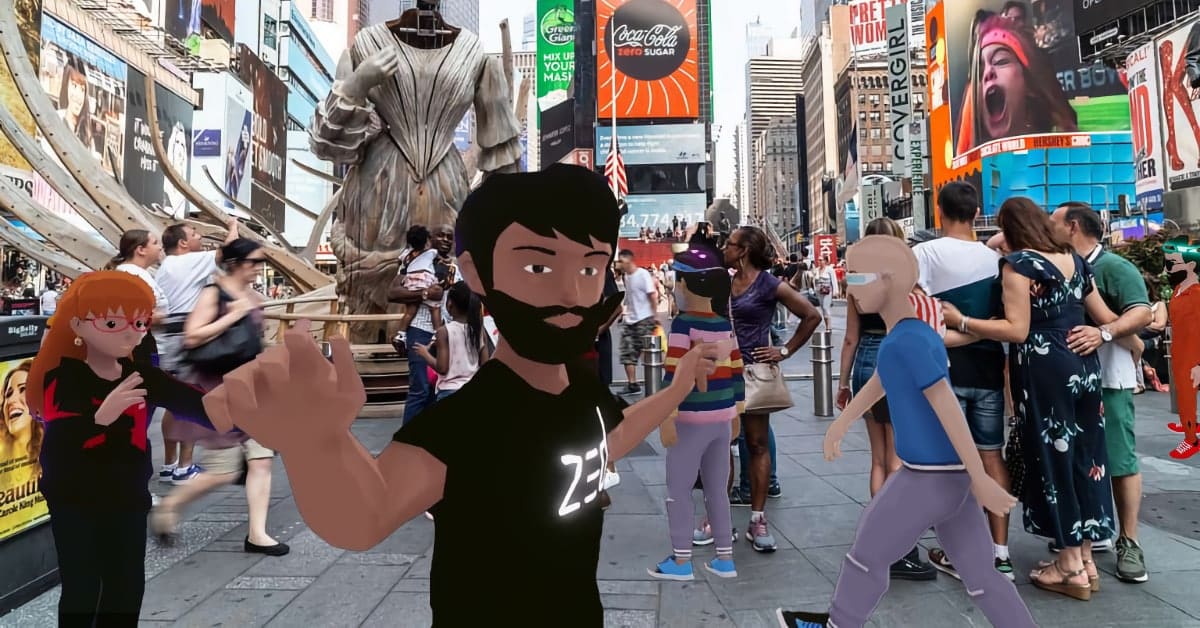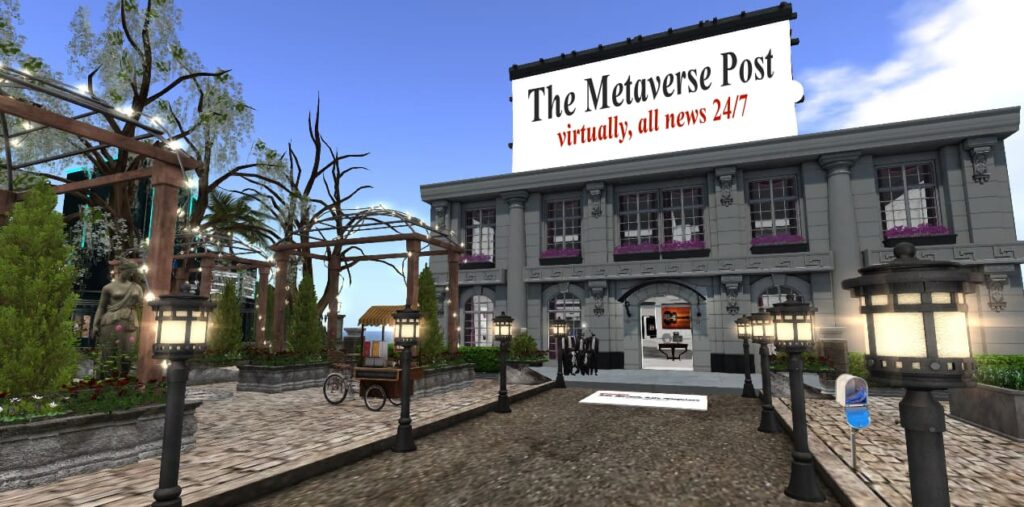Ever since Mark Zuckerberg famously renamed his company “Meta,” people have been busy talking about the concept of a metaverse. While some have a deep understanding of the idea behind it, others simply want to be part of the conversation.
We assume you want to be part of the former, so we decided to write this complete Metaverse Guide for beginners and experts to dive deep into this new Universe.
In this article, we will explain the definition of a Metaverse, talk about the proposed inner workings, and why now is the perfect storm that brings all elements together to create this new virtual world. Also, we will describe how it could change your life, (hopefully) for the better.
To facilitate a better understanding, we will also provide practical examples and step-by-step instructions on how to get started in the current and most popular Metaverses of 2022. Welcome to the Metaverse!
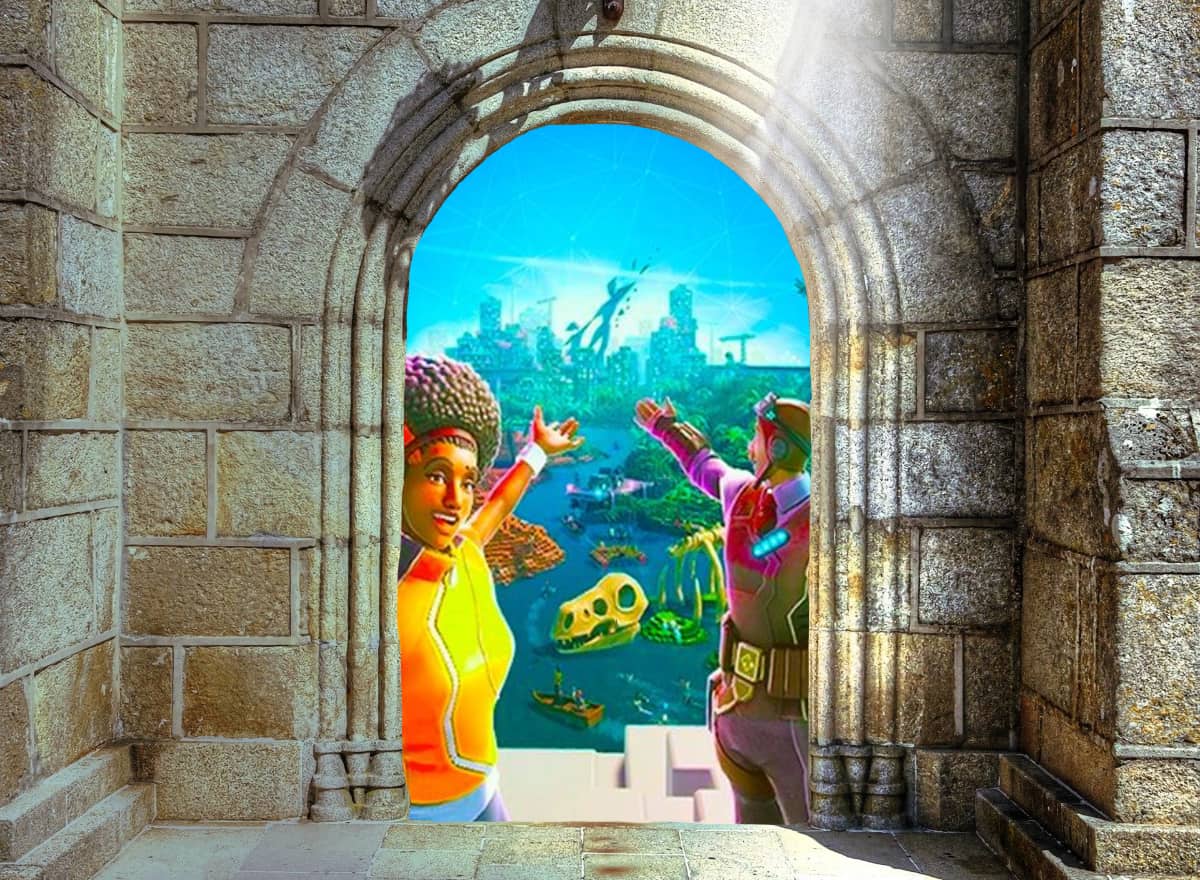
The idea of the Metaverse brings many possibilities, spread out in all forms of human interaction. It is set to revolutionize communication, entertainment, and even business.
As such, you can’t afford to be left out of the loop and to realize its full potential, I can only urge you to learn about the Metaverse early on. So let’s get to it with this in-depth guide on the Metaverse so you’ll be a Meta Master in less than 15 minutes…
The Concept of a Metaverse — A Brief Explanation
The term “metaverse” comes from a 1992 sci-fi novel by author Neal Stephenson. The Metaverse is an alternate, digital universe depicted in the novel “Snow Crash” as an urban environment standing on the side of a wide road.
Neal Stephenson’s virtual universe is eerily similar to what today’s Metaverse is gearing up to become – except for the dystopian setting, of course.

Around the time “Snow Crash” was published, another major event took place in the world: the advent of the internet. Around then, the internet was a mysterious concept to most, similar to what the Metaverse is today. However, that’s only the beginning of the similarities: we can go so far as to say that the Metaverse is “Internet 2.0.”
The modern idea of a Metaverse is a virtual universe that centers around its users. Each user will have a virtual alter-ego called an “avatar.” The term comes from the Sanskrit language and has been an internet staple for many years.
However, what started as a simple forum profile picture will now be much more. In the Metaverse, your avatar will represent your entire look and personality. We’ll touch on that later, with a couple of practical examples.
The Metaverse aims to become a virtual parallel universe where people can do almost everything they do in real life. It can potentially change how we look at communication, work, travel, entertainment, and possibly every other aspect of our existence.
The Metaverse Defined and Dissected
A short definition of a Metaverse is: “a 3D virtual (online) space with a persistent identity where real people can interact in real-time in a single, universal world facilitated by Mixed Reality headsets.”
Now let’s dissect this short definition into the 3 pillars of a Metaverse to really start to understand its definition:
A Boundless Virtual Space
A digital place where people can interact as if they are together in real life, regardless of where they are in the real world. This place is not limited to one company or platform but is fully interconnected and inter-compatible so that it works for anyone and everyone.
Persistent Identity
In psychology, persistent identity is defined as the uninterrupted connection of a person and his or her private life and personality. It is the ability to perceive the relationship between oneself and one’s environment consistently from one moment to the next.
For the Metaverse to work, persistent identity is key, as everyone who visits the Metaverse needs to see the same things in the same place at the same time.
Real Social Interactions
The interconnectedness between people in this virtual world needs to be real and can be thought of as talking to one another in a work environment or playing a video game quest together. As time will pass these interactions will become better and more real so that the line between real-life and virtual life will slowly fade.
Why is the Metaverse exploding Now?
Virtual universes already exist and have existed for a while now. So what’s the reason behind all the recent talk about the Metaverse? Well, marketing is one of them. Mark Zuckerberg’s renaming of Facebook into Meta was a big deal in the business community. However, there is a more important reason: technological breakthroughs.
Mixed Reality and Hardware
To offer a serious upgrade to the existing virtual universes, you’d need serious hardware. A mouse, keyboard, and monitor are great, but they’re becoming somewhat stale. We’ve been using them for quite some time, and if our virtual experience changes, our hardware needs to bring something new to the table. That’s where technological advancements come into play.
A virtual world requires the highest of high-tech technologies. To properly immerse yourself in the Metaverse, you’ll need serious hardware, such as some of the recent VR headsets AR Glasses, and (haptic-feedback) controllers. We also see an ever-expanding number of smart devices, such as watches, VR headsets (and soon, AR glasses).
They can offer something no monitor can – a virtual experience that is much closer to reality than what conventional hardware provides. The availability of these new technologies is crucial to taking the next step towards a completely virtual experience.
Virtual Platforms and Technology
VR headsets are only the beginning of Metaverse technology. Although groundbreaking, they arouse only two of our five senses: sight and hearing. What about the other three? Well, while there are no indications of virtual technology that can provoke smell, taste, and touch, we’re sure that it’s in the works.
Holograms are another exciting new way to delve into the virtual reality of the Metaverse. More interestingly, holographic images can blend the real and virtual worlds. Consider Tony Stark and his holographic keyboard, which allows him to move his hands in real life while giving commands in the virtual one. When we think about it, it’s hard to imagine a scene where Tony Stark does not mix the two worlds.
Computing and Networking
As hardware and virtual platform and technology are evolving, so is the need for more computing power. Being able to run a Metaverse, will require the greatest ongoing computational resources ever needed in human history.
Today’s most popular Metaverse-like companies, such as Decentraland or Roblox, are not even close to what is needed for a full-blown Metaverse to work smoothly and with limitless boundaries.
To put things in perspective, Roblox (which is a pretty low-fidelity world) is currently testing environments with 1000 players on 1 server, whereas a Metaverse would need to host tens of thousands…
Besides the constraint of the current computing power of both the companies running the Metaverse and consumers, there’s also the constraint of providing high bandwidth that can deliver persistent and real-time connections between the networks, services, and consumers.
This ‘networking bottleneck’ can make or break the adoption of the Metaverse as an unreliable user experience will quickly scare consumers away. So what needs to be improved for a reliable network to work within the Metaverse?
- Increased bandwidth; is the amount of data that needs to be transferred over the cloud.
- Innovative latency solutions; the time it takes for data to travel from one point to another and back.
- Overall reliability; overall uptime as well as the consistency of bandwidth and latency.
For the Metaverse to work, all the above requirements need to be significantly improved, regardless and independent of the hardware or computing power improvements so that information can effortlessly flow from one user to another.
The good news is that broadband internet and cloud computing have been taking off all while there has never been this much money poured into the gaming industry, all playing their part in the explosion of the Metaverse.
Interchangeable Assets and Payments
I think most of us must have noticed the explosion of NFT’s over the past months, laying the groundwork for what the Metaverse will also need to work on. You might have seen them as digital artworks, but there’s more to NFT’s and the technical solutions behind them.
The protocols and services that are currently being developed will ignite the ability to use and transfer assets within the Metaverse. Being on a public ledger through blockchain technology enables interoperability between different (virtual) worlds and enables payment transactions around it.
The decentralized solutions that are being developed now will offset the costs of multiplatform development and ensure that there will be no monopoly on the Metaverse (although Meta is trying).
We would want as much of the current world to integrate into the Metaverse, meaning that we need to find ways to interconnect the many devices and platforms that we use today.
This includes financing and digital payment solutions, as its economy will primarily evolve around virtual goods which are bought with digital (crypto)currencies. As of now, the transactions and costs are far from optimal, and innovation is still needed to make payments fast, low-cost, and easy to use. In theory, the virtual world should have “better” payment systems than the “real world” for mass Metaverse adoption to happen.
The continuous discovery of new technologies and hardware, the integration of blockchain and NFT, and the boom of stronger computer chips and power are among the many reasons that Metaverse talk has lately become so popular. It is the perfect storm and with each passing day, new and previously unheard-of possibilities open up. It’s truly an exciting time to be alive.
To better understand what this means, let’s follow up on some practical examples and how to get started in a Metaverse yourself.
A Guide on How to Start in the Metaverse
There are a handful of companies that make headway in the Metaverse space and my guess is that only those with some serious backing will be able to sustain the growth and capital investments needed. Besides Mr. Zuckenburg entering the space, there are a few crypto and gaming companies also having their aim at the Metaverse crown.
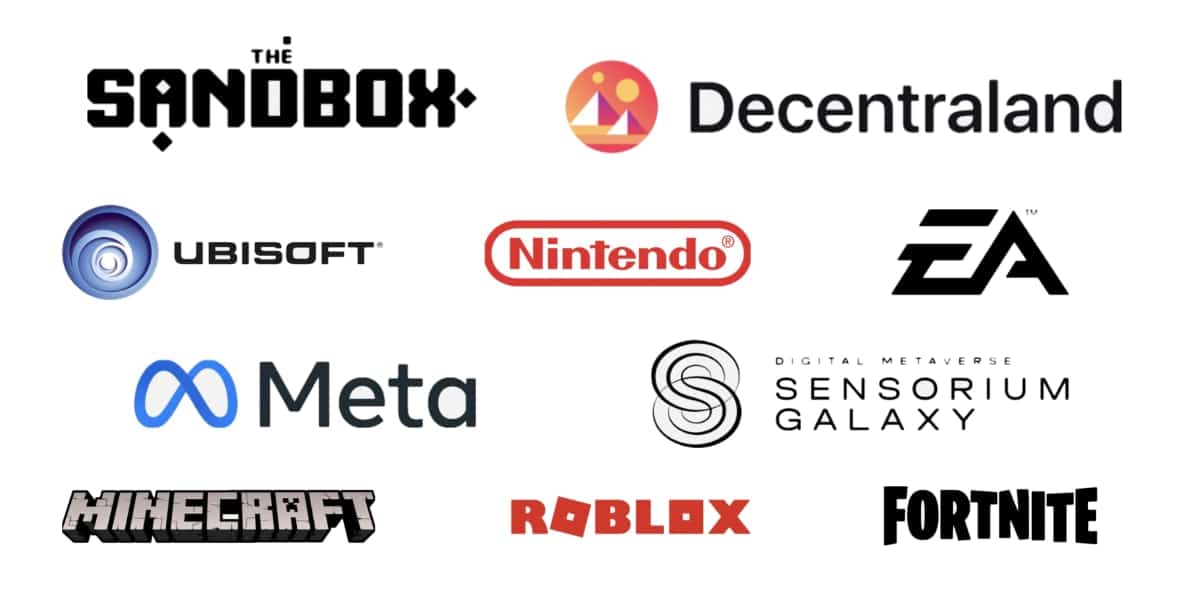
Below I will share how to get started in the currently most developed Metaverse examples to experience a tat bit of how the future will feel like…
Decentraland
My suggestion if you want an easy way to get started in a Metaverse is to start with Decentraland. It is one of the most popular metaverse platforms around the world and for this one you do not need any crypto wallet (you can though), and play as a guest on a laptop without the need of a computer with Windows.

To get started playing in Decentraland, go to play.decentraland.org and simply click play as a guest! It will download the latest web version of Decentraland, then asks you to create your Avatar, fill out your screen name and you are ready to go.

You can either start playing different games with other people or start exploring Genesis Plaza, the starting point within Decentraland. This is where most other users hang out and where you can start communicating with others.
Overall, it is fun to experience a basic Metaverse for yourself but a lot is still needed to make this something you really want to spend your days in.
The Benefits of A Metaverse
The Metaverse aspires to provide a virtual alternative to the real world in every possible aspect. Therefore, you can be sure that it will make the most of communication, human interaction, business, entertainment, and many more. Let’s quickly examine these areas of life and find out how the Metaverse can improve them.
1. Human Interaction in the Metaverse
One of the primary purposes of the internet is communication, and it’s a similar story to the Metaverse. However, the Metaverse shows the potential to take this to another level.
Nowadays, we use the internet for all kinds of interaction, from friendly chit-chat to important business meetings. However, imagine having a virtual meeting with your colleagues from the comfort of your living room. It sounds contradictory, but that’s exactly what the Metaverse can offer. Remember, you’re in your living room, but your avatar doesn’t have to be. Using your virtual alter-ego, you can practically be in two places at once.
It’s a similar story with friendly interactions. In the Metaverse, you and your buddies can have a drink together, despite being miles away from each other in the real world. You just need to wait for some virtual bars to be built.
If you’re eager to spend some virtual time with your friends – try one of the games we previously mentioned. For some time now, online gaming has been away for friends to socialize. While we’re on the subject of gaming, let’s turn our attention to another critical aspect of the Metaverse: entertainment.
2. New Ways to Be Entertained
The Metaverse will likely transform how we look at specific forms of entertainment, primarily audio-visual ones. The gaming industry has already started to adopt various VR technologies—VR sets and controllers are quite common among today’s gamers. They can offer unparalleled immersion in both the visual and auditory senses.
While the gaming industry is the quickest to implement VR, other forms of entertainment are not that far behind. As the Metaverse comes into fruition, it will include virtual concerts, plays, and even movies. Imagine using virtual reality technology to watch a movie – you’d feel like you were one of the characters! Although, if you decided to try this with “The Matrix,” things might get a little too complicated.
In any case, the entertainment industry is, as always, the early bird. You can bet that any technological findings related to the Metaverse will first be tested for the purpose of having fun. Only after that can technology be used for something practical. Speaking of practical stuff, let’s review the business opportunities the Metaverse offers.
3. Doing Business in the Metaverse
The coming of the Metaverse will create many new ways of doing business. While we cannot be sure what this will bring, we are confident in one thing: it will revolutionize digital marketing. After all, this has happened before.
A while ago, the rapid rise in popularity of social networks changed digital marketing forever. Pop-up ads are all but gone, and influencers quickly take their place. The Metaverse will bring about similar changes.
Today, online shopping is one of the more popular ways to spend money. Naturally, a full-blown Metaverse will probably offer a complete revamp of the shopping experience, allowing your avatar to walk into a digital store and try stuff out instead of you.
Nonetheless, it won’t start that big – expect smaller steps initially. For example, let’s say you’re buying shoes online. The website has many pictures of the ones you like, but pictures don’t always do a product justice. A virtual 3D model, on the other hand? That could be correct.
4. Digital Ownership
Non-fungible tokens are another way the Metaverse will influence online businesses. Simply put, they are individual digital files, sometimes sold for ridiculous prices. While NFTs are popular right now, they can only show their true potential in a complex virtual universe.
Think of it this way: today, you can buy a .jpeg as an NFT, but you don’t have any use for it. However, what if you own a house or a store in the Metaverse? Then, your NFT won’t be just a useless file – it can be part of your interior decoration.
By mentioning houses and stores, we’ve arrived at our next point: digital real estate. Just like in the real world, ownership of real estate will be a thing in the virtual world of the Metaverse. The rules are likely to be the same: size, location, and neighborhood – all of these factors will impact the price of your digital home, store, or office.
The concept of ownership of virtual goods is not a new one. In fact, it has been present in the gaming industry for some time now. Rare skins for your characters, rare weapons, and armor are all basically bits of information in a virtual world. Still, they’ve been known to sell, and some of them fetch incredible prices, too.
How Close Are We to a Full-Blown Metaverse?
All these promises sound very good, but where do we stand right now in terms of virtual reality technology? Well, we could say that we’re at the tip of the iceberg. The ideas are there: realistic avatars, blockchain technology, cloud computing, hardware, and companies and VCs are backing it with cold hard cash.
If we believe ARK invest, revenues from virtual worlds will hit 400 billion by 2025 (gaming and VR combined), up from 180 billion in 2021, so that just might be enough reason to keep tuned-in…
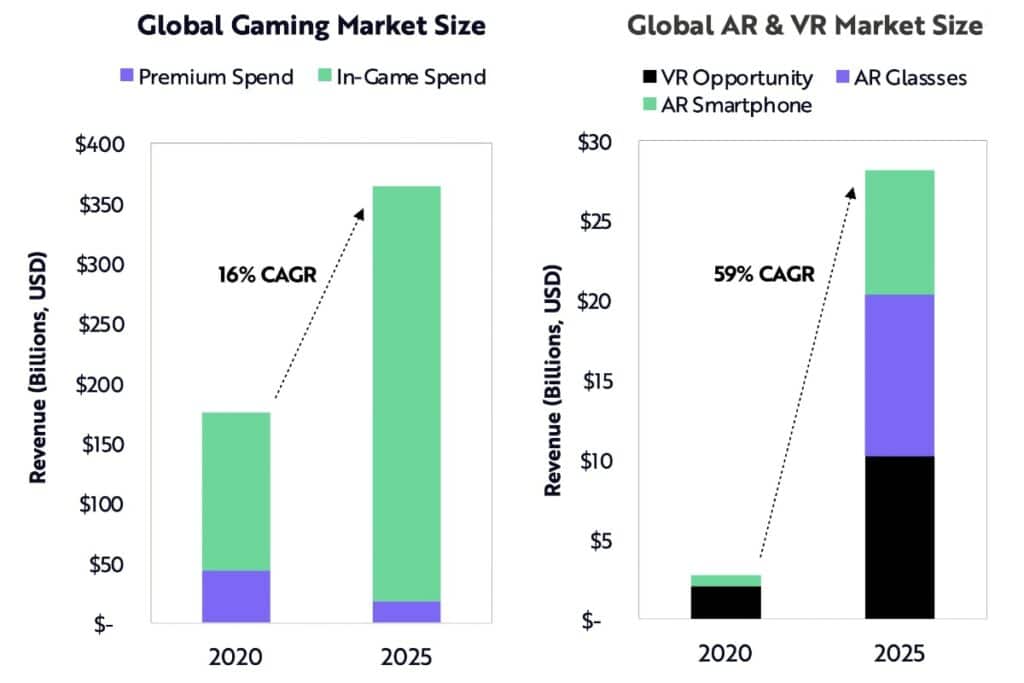
And yes, we’ve all seen the recent rise in the popularity of virtual conferences and the explosion of more than-realistic open-world multiplayer games. However, they’re still far from perfect.
Even with 20 people, video chatrooms have difficulties providing a smooth user experience. You can imagine what will happen when millions, or even billions, of people, are on a single global Metaverse server.
Since VR technology is not entirely where it needs to be, I’d advise some cautious optimism regarding the Metaverse. Technology has a long way to go if it hopes to fulfill the current promises of a virtual world and will probably take another 5 to 10 years to fully develop.
However, we do live in exciting times, and being present at the birth of the Metaverse can be just as exciting as being part of it!
Questions on the Metaverse
Below I’ll discuss the most frequently asked questions by my readers on the Metaverse, but feel free to ask yours as well in the comments below this post!
What do I need to experience the Metaverse?
Well, first of all, you will need a lot of patience. As we said earlier, the technology that could provide the whole sci-fi experience simply doesn’t exist right now. However, if you’re an early adopter or a tech enthusiast, try a VR headset. There are several good ones on the market, and they’ll do a fine job of showing you a glimpse of the potential of the upcoming Metaverse.
Will life in the Metaverse be safe?
As almost every user knows, the internet can be a dangerous place. Phishing, identity theft, and credit card fraud are only some of the many ways the internet can do you harm. Since criminals always find a way to exploit technology, we predict that the coming of the Metaverse will increase the number of these exploits. There will be more personal information to steal and more ways to do it.
We’re optimistic that the relevant authorities are already working on legal means to stop this from happening. However, just like with the internet, it doesn’t hurt to be careful.
Prepare for a New Reality
We cannot be sure when and how, but one thing is certain: the Metaverse is coming, and it will completely change our lives. This new virtual world will become a part of our everyday lives, just like the internet did, quickly after it came to life.
This is why I’d strongly recommend learning about the Metaverse concept – that way, when it finally comes, you’ll be ready to quite literally dive in. Here you can get a head start by subscribing to these metaverse newsletters and reading these metaverse books.
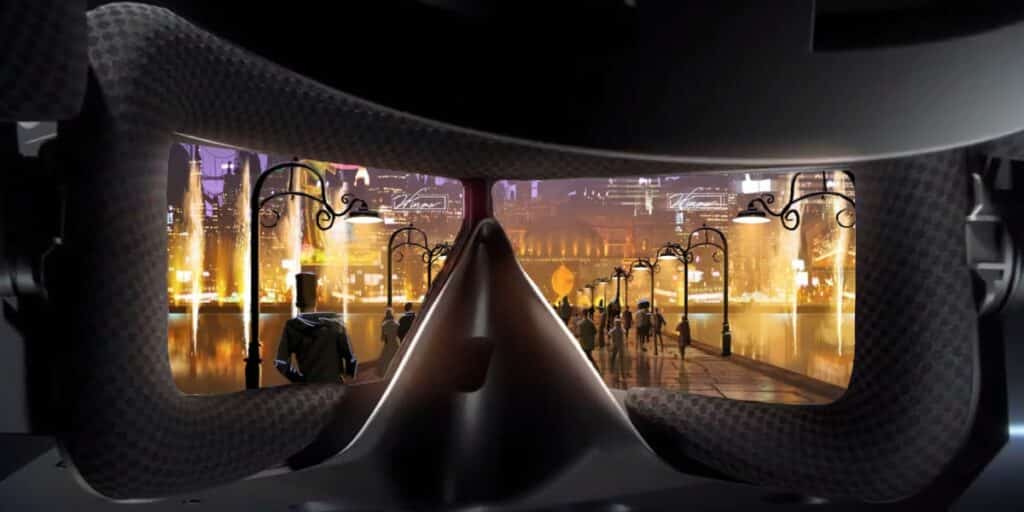
The prediction is that once set up, the Metaverse will quickly begin to influence critical aspects of our online presence: communication, entertainment, and business.
The Metaverse will make friendly and professional communication more engaging. It will also take entertainment to the next level, providing a more immersive experience than ever before. Finally, the way you’re doing business – online and offline – will change irreversibly.
All this might sound exciting and a little scary at the same time. Don’t worry, though: we’re not there yet. For the Metaverse to become (virtual) reality, VR technology will need a serious upgrade. Nevertheless, the groundwork has already been laid, and now it’s time to start putting things into place.
There are a couple of things to do while you wait for the Metaverse. Firstly, learn about the Metaverse now and try to think about what it aspires to be. We hope our article was of some use in that regard. Secondly, if you have the funds for it, buy a VR/AR headset and look at it as a trailer for the real thing.
Other than that, there is nothing to do but wait patiently… Have you experienced the Metaverse yet? Let me know what you think of your first try in a Metaverse and where you think it’ll involve towards the future in the comments below. Can’t wait to meet you – in the Metaverse or real-life!

